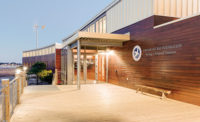U.S. Government Directs $12 Million To Research Building Energy Conservation
The U.S. Dept. of Energy recently announced a dozen research grants, valued at about $12 million in total, to develop energy-efficient building technologies as well as open-source energy-efficiency software for both residential and commercial buildings. The projects will receive approximately $11 million from DOE and another $1 million in private funding.
Commercial and residential buildings use nearly 40% of the total energy consumed in the U.S. each year and produce more than 40% of the nation's carbon pollution, says DOE. According to the Energy Information Administration, about 48% of energy consumption in U.S. homes in 2009 was for heating and cooling, down from 53% in 1993. The projects announced on Aug. 14 are intended to increase further conservation.
About $6 million is going to nine projects that will develop heating, ventilating and air-conditioning (HVAC) systems and building insulation. The projects also will help curb emissions of hydrofluorocarbons, or greenhouse gases primarily used in refrigeration and air conditioning. In the U.S., emissions of HFCs are expected to nearly triple by 2030. HFCs currently account for 1.5% of greenhouse-gas emissions. That level is expected to double by 2020, says DOE.
Among the projects is a $750,000 grant to develop affordable insulation plastic film for large windows. The National Renewable Energy Laboratory is carrying out the research.
Another $750,000 investment is aimed at a demonstration project for a rotating heat exchanger technology for residential HVAC systems. The heat pump will improve HVAC-system cycle efficiency and increase the use of heat pumps in colder climates, says DOE. Sandia National Laboratories and the United Technologies Research Center have the contract.
Thermolift, Oak Ridge National Laboratory, Stony Brook University and National Grid will receive $750,000 to help commercialize a natural-gas heat pump to provide heating, cooling and hot water for homes and commercial buildings. The all-in-one unit will not use harmful hydrofluorocarbons and refrigerants and could triple space-heating efficiency, says DOE.
DOE is investing up to $5 million for three projects to develop open-source software that helps building owners and operators measure, monitor and adjust lighting, HVAC and water-heating energy use to save energy without compromising performance. The projects are led by the University of California, Virginia Tech and Carnegie Mellon University. According to a study by the Pacific Northwest National Laboratory, commercial building owners could save an average 38% on heating and cooling bills by installing energy control systems.




